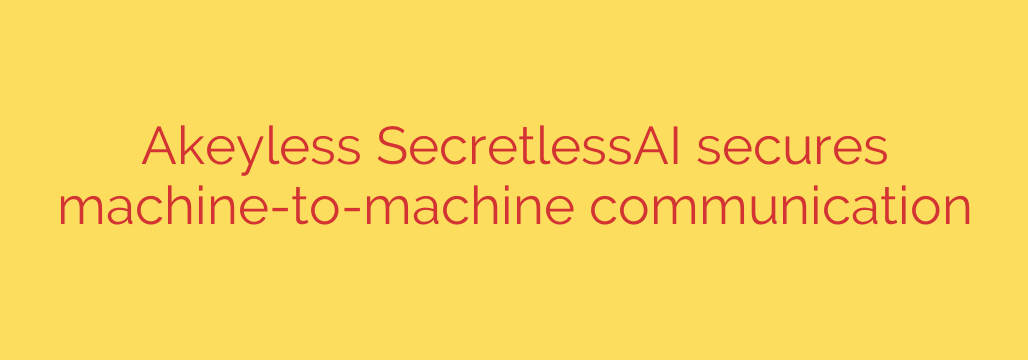
Beyond API Keys: How Secretless Frameworks Are Revolutionizing M2M Security
In today’s interconnected digital landscape, applications rarely work in isolation. They constantly communicate with databases, APIs, and other services in a complex web of machine-to-machine (M2M) interactions. Securing this communication has traditionally relied on a fragile foundation: secrets. API keys, database credentials, and authentication tokens are the digital keys that grant access, but managing them has become a significant security challenge.
The problem, often called “secret sprawl,” is that these credentials must be stored somewhere. Too often, they are hard-coded into applications, stored in configuration files, or left in unsecured environment variables. This creates a massive attack surface. A single leaked secret can give an attacker a direct line into your most sensitive systems, leading to catastrophic data breaches.
Fortunately, a new architectural approach is emerging to solve this fundamental problem by removing secrets from the equation entirely—at least from the application’s perspective.
The Problem with Traditional Secret Management
For decades, developers have been tasked with the difficult job of managing application secrets. The standard process involves embedding credentials into the application’s environment so it can authenticate itself to other services.
This approach is fraught with risk:
- High Exposure: Secrets stored in code or configuration files are highly vulnerable to being leaked through repository breaches or unauthorized access.
- Difficult Rotation: Changing a compromised secret often requires redeploying multiple applications, a slow and cumbersome process that discourages regular rotation.
- Lack of Centralized Control: When every application manages its own secrets, it’s nearly impossible to get a clear, auditable picture of who has access to what.
This model forces developers to become security experts, placing an undue burden on teams and slowing down innovation. The core issue is that applications themselves should not need to know the secrets they use to access other resources.
The Rise of the Secretless Architecture
A secretless framework fundamentally changes how applications authenticate. Instead of embedding credentials within the application, this model introduces an intelligent broker or sidecar that manages the entire authentication process.
Here’s how it works:
- An application needs to access a protected resource, like a database.
- Instead of using a stored password, the application makes its request through a local secretless broker.
- The broker intercepts the request. It then authenticates the application itself, based on its unique machine or workload identity, not a password it possesses.
- Once the application’s identity is verified, the broker securely fetches a temporary, just-in-time credential from a central vault.
- The broker injects this credential into the request and forwards it to the database.
The application gets the access it needs without ever handling a long-lived, static secret. This elegant solution decouples applications from the credentials they use, dramatically improving security and simplifying development.
Key Benefits of Going Secretless
Adopting a secretless paradigm offers substantial advantages for security, development, and operations teams.
- Dramatically Reduced Attack Surface: By removing static secrets from your code, repositories, and CI/CD pipelines, you eliminate the primary target for many attackers. There are simply fewer credentials to steal.
- Centralized Security and Auditing: All access requests are funneled through the secretless broker and managed by a central secrets vault. This provides a single point of control for enforcing policies, monitoring access, and generating comprehensive audit logs.
- Simplified and Accelerated Development: Developers can focus on building application features instead of implementing complex security logic for handling secrets. This removes a major point of friction in the DevOps lifecycle.
- Automated and Seamless Credential Rotation: Since applications no longer store secrets, credentials can be rotated frequently—even for every transaction—within the central vault. This can be done without requiring any changes or redeployments of the applications themselves.
Actionable Steps to Secure M2M Communication
Transitioning to a fully secretless environment is a journey, but you can take immediate steps to strengthen your M2M security posture.
- Conduct a Secrets Audit: Your first step is to identify where all your current secrets are stored. Scan your code repositories, configuration management tools, and CI/CD systems to understand the extent of your secret sprawl.
- Centralize Secrets in a Vault: Move all identified secrets out of insecure locations and into a dedicated secrets management solution. This provides a secure, central repository for all credentials.
- Prioritize Dynamic, Short-Lived Credentials: Configure your vault to issue just-in-time (JIT) credentials that are valid for a very short period. This ensures that even if a credential were to be intercepted, its window of usefulness would be extremely limited.
- Embrace Application Identity: Begin implementing authentication based on application identity (e.g., using platform-specific identities like SPIFFE, AWS IAM Roles, or Kubernetes Service Accounts) rather than shared secrets.
- Pilot a Secretless Framework: For new projects or non-critical services, pilot a secretless broker to see how it fits into your architecture. This allows your team to gain hands-on experience with the technology in a controlled environment.
As enterprise environments become more distributed and complex, securing machine-to-machine communication is no longer optional. The secretless approach represents a critical evolution in DevSecOps, shifting the focus from managing secrets to eliminating them from the application layer. By doing so, organizations can build more resilient, secure, and agile systems fit for the modern era.
Source: https://www.helpnetsecurity.com/2025/07/17/akeyless-secretlessai/








